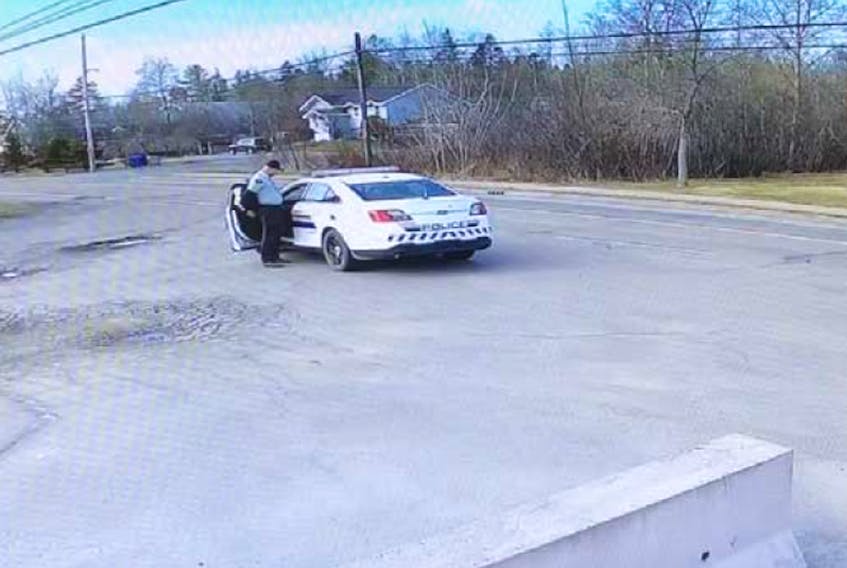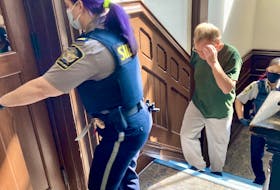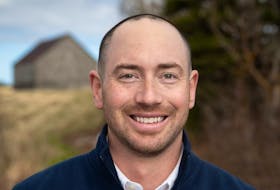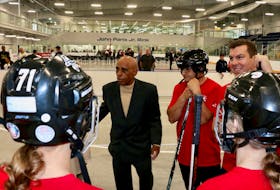Note — SaltWire will only use the killer’s name when it serves a greater public good, and when we do, we will endeavour to explain it. This article does not contain his name.
While hunting for a Nova Scotia killer who was masquerading as an RCMP officer, a real Mountie was inside his marked cruiser waiting for a colleague. Then he spotted a police car approaching.
Const. Chad Morrison was apprehensive. Was this his colleague or the rampaging gunman? He had a photo of the suspect with him, sent with an alert for officers to be on the look out for him. He knew the killer was dressed as a Mountie.
From inside his marked RCMP SUV, Morrison used his police radio to ask the other officers on duty who was driving towards him on Highway 224. His colleague, Const. Heidi Stevenson, who was on her way to the rendezvous, said she was.
Relieved, Morrison moved his SUV onto Highway 224, facing Highway 2, near a stop sign, to be in a better position to speak window-to-window with her.
It was not his colleague driving the police car.
The RCMP, for its probe of the tragic spree shooting in Nova Scotia from April 18 to April 19 — the worst rampage killing in Canada’s history — interviewed Morrison three days afterwards about how he and Stevenson were ambushed by the killer.
In response to a court challenge by several media groups, including Postmedia, details of Morrison’s interview were included in a large volume of police documents released this week.
Morrison, an 11-year veteran with the force, said he was working in uniform on general duty out of the Enfield detachment in East Hants the morning of April 19. He was aware of what was happening in Colchester County, the neighbouring district.
Over his police radio, he heard a supervisor ask for two East Hants RCMP members to come to Colchester to help with the manhunt. Stevenson told Morrison to meet her at the intersection of Highway 2 and Highway 224 in Shubenacadie to head over together.
He estimated this was 10 a.m.

Morrison arrived at the rendezvous first, he said, and parked just south of the Shubenacadie Wildlife Park.
As he listened to his police radio, he found it “confusing to understand” where the suspect was, but thought he was in the Brookfield area, a little more than 20 kilometres to the northeast, according to the summary of his interview. The gunman’s first victims were killed in Portapique, about 70 kilometres away.
Morrison “was not expecting the suspect to be coming his way,” the RCMP’s summary says.
As he waited for Stevenson, he saw a white Ford Taurus heading his way. It was a few hundred metres from where he was parked and he wondered if this could be the fugitive gunman.
That’s when he asked his fellow officers which of them was driving towards him.
In hindsight, information on where the gunman was thought to be could have been clearer and Morrison’s question or Stevenson’s answer could have been more precise. Both Stevenson and the killer were driving towards him.
The killer got there first.
As the cruisers drew closer, Morrison spotted a black push bar on the front of the approaching car. These are the metal bars sometimes installed on police cars so it can be used as a battering ram or to push vehicles out of the way.
Most RCMP cruisers in the province aren’t fitted with a push bar. Morrison knew that.
“It made him pause,” the summary said, but because Stevenson had said it was her, he “relaxed.”
“Other than the black push bar, there was nothing different about the marked police car,” he said, according to the summary.
Nothing else caused alarm. the gunman’s fake cruiser drove at a normal speed. When they got close enough, though, Morrison saw the driver was a man. The killer, a Dartmouth denturist, turned left onto Highway 224 so he would be driver side-to driver side with Morrison, the way police do when talking to a colleague in another car.
That is when Morrison realized the driver was the gunman they were searching for. The killer “looked to have a melancholy expression” as he turned in front of him, and then a look of “grit” as he raised his gun.
The killer pointed a silver handgun out the window and started shooting at Morrison, probably three or four times, he said.
“It happened in a split second.”
Morrison “floored it,” and took off from where he was parked.
He had been hit but he was mobile and his cruiser hit the guardrail as he turned it onto Highway 2. He pushed his emergency alert button on the side of his police radio. It is to tell the dispatcher the officer requires immediate assistance. He hit the button several times but didn’t think his message was received.
He called on his radio to say he had been shot and was going to an ambulance station about seven kilometres away, in Milford.
Nobody was there when he arrived; the doors were locked. He radioed again for help.
He felt like “a sitting duck” outside in the parking lot if the killer followed him, he said, so he grabbed his rifle and went behind the station.
As he waited for help to arrive, he looked out onto Highway 14. He saw black SUVs with police lights driving towards him and then head towards the scene of where he was shot.
He listened to his radio as he heard that two police vehicles were on fire at the scene and that an officer was down. Someone said the officer’s service gun and two magazines of ammunition were missing. Perhaps he hoped it was the fugitive gunman.
Then he heard the grim message.
“Stevenson is down.”
Stevenson, 48, a 23-year veteran of the force, a wife and mother of two, died at the scene.
By then, an ambulance arrived and took Morrison to Colchester hospital.
Back in Enfield, where Morrison started his shift, the gunman was shot and killed by police at a gas station. He had killed 22 people.
Some information from Morrison’s account remains redacted by the Crown.
The document does show that something went right that day.
“I believe that the hard body armor worn by Cst. Morrison stopped the bullet from entering his chest/abdomen,” an RCMP officer wrote in the document.
He was released from hospital the next day with bandages around both arms.
• Email: [email protected] | Twitter: AD_Humphreys
Copyright Postmedia Network Inc., 2020









